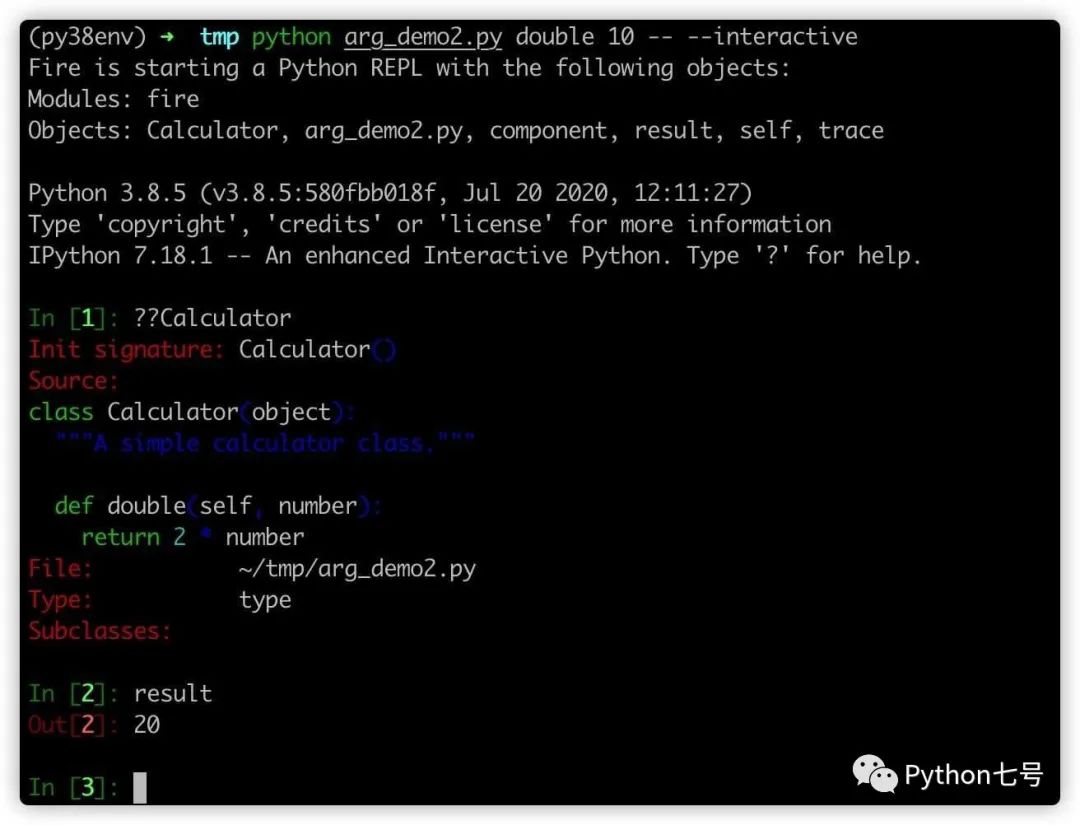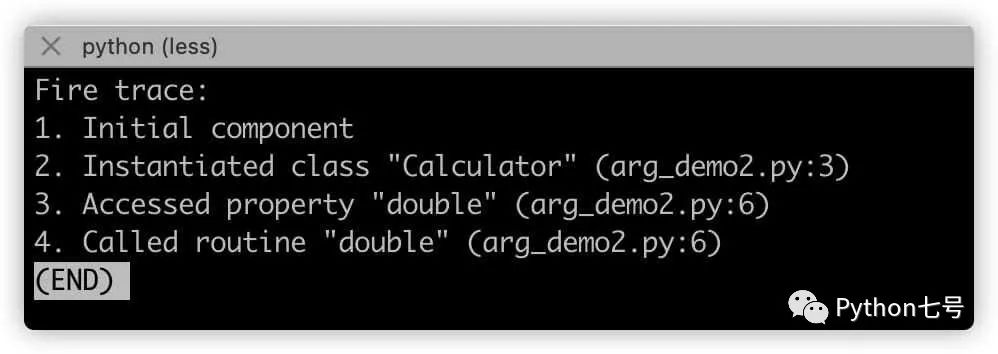1. python-fire
python-fire 是一个三方库,可以将任何 Python 对象变成一个命令行接口。
使用前先 pip install fire 下。
可以把你的函数直接变成命令行接口:
import fire def hello(name="World"): return "Hello %s!" % name if __name__ == "__main__": fire.Fire(hello)
然后在命令行,就可以执行这些命令:
python hello.py # Hello World! python hello.py --name=David # Hello David! python hello.py --help # Shows usage information.
也可以把可以把你的类直接变成命令行接口:
import fire
class Calculator(object):
"""A simple calculator class."""
def double(self, number):
return 2 * number
if __name__ == "__main__":
fire.Fire(Calculator)
然后就可以这样执行:
python calculator.py double 10 # 20 python calculator.py double --number=15 # 30
除此之外,还有这样的功能:
执行后自动进入交互模式:
command -- --interactive
比如:

查看执行的调用顺序:
python arg_demo2.py double 10 -- --trace
结果如下:

还可以为你生成 shell 自动补全命令的脚本,真的很贴心:
python arg_demo2.py double 10 -- --completion
2. mando
mando 是一个基于 argparse 的装饰器,可以让你在几秒内编写出一个灵活、可维护的命令行工具。
使用前先 pip install mando 下。
用法:
example.py
from mando import command, main
@command
def echo(text, capitalize=False):
"""Echo the given text."""
if capitalize:
text = text.upper()
print(text)
if __name__ == "__main__":
main()
命令行用法:
$ python example.py -h
usage: example.py [-h] {echo} ...
positional arguments:
{echo}
echo Echo the given text.
optional arguments:
-h, --help show this help message and exit
$ python example.py echo -h
usage: example.py echo [-h] [--capitalize] text
Echo the given text.
positional arguments:
text
optional arguments:
-h, --help show this help message and exit
--capitalize
真实执行结果:
$ python example.py echo spam spam $ python example.py echo --capitalize spam SPAM
再复杂一点的:
from mando import command, main
@command
def push(repository, all=False, dry_run=False, force=False, thin=False):
"""Update remote refs along with associated objects.
:param repository: Repository to push to.
:param --all: Push all refs.
:param -n, --dry-run: Dry run.
:param -f, --force: Force updates.
:param --thin: Use thin pack."""
print ("Pushing to {0}. All: {1}, dry run: {2}, force: {3}, thin: {4}"
.format(repository, all, dry_run, force, thin))
if __name__ == "__main__":
main()
mando 可以理解 Sphinx 风格的文档字符串中的 :param 参数说明,因此可以显示帮助文档。
$ python git.py push -h usage: git.py push [-h] [--all] [-n] [-f] [--thin] repository Update remote refs along with associated objects. positional arguments: repository Repository to push to. optional arguments: -h, --help show this help message and exit --all Push all refs. -n, --dry-run Dry run. -f, --force Force updates. --thin Use thin pack.
mando 还可以理解 Python3 的类型提示,因此传错了参数,也会有报错提示:
from mando import command, main
@command
def duplicate(string, times: int):
"""Duplicate text.
:param string: The text to duplicate.
:param times: How many times to duplicate."""
print(string * times)
if __name__ == "__main__":
main()
执行:
$ python3 test.py duplicate "test " 5 test test test test test $ python3 test.py duplicate "test " foo usage: test.py duplicate [-h] string times test.py duplicate: error: argument times: invalid int value: "foo"
最后的话
本文分享编写建命令行工具的三方库,使用起来非常简单,我也是偶然在 GitHub 搜索到的,写代码前先在 GitHub 上搜一下真的是一个很好的习惯,以上就是Python编程编写完善的命令行工具的详细内容,更多关于Python编写完善的命令行工具的资料请关注服务器之家其它相关文章!
原文链接:https://blog.csdn.net/somenzz/article/details/118166073










